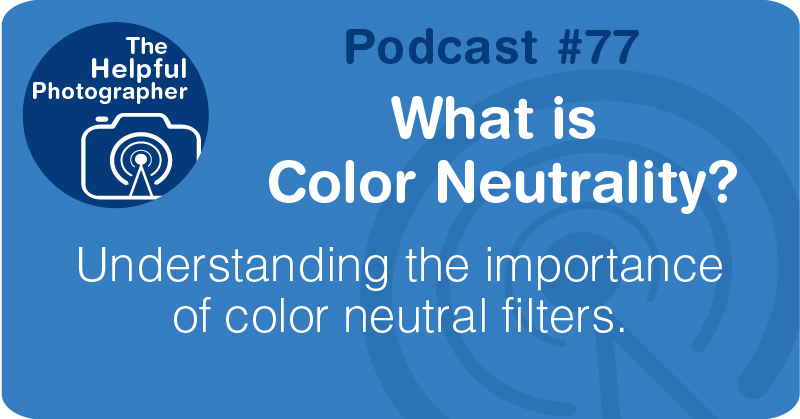What is Color Neutrality #77
Photo Tips Podcast: What is Color Neutrality #77

iTunes
Google
Audible
Tune In
Stitcher
RSS
Pandora
Transcript
What is Color Neutrality #77
A couple of weeks ago, I cracked one of my very expensive ND filters and since it’s been more than 5 years since I purchased an ND filter, I thought it was time to do some research into what the latest and greatest is. And what I’m finding is a lot of discussion around the issue of color neutrality. On the upper end, almost all the manufacturers claim that their filter is color neutral and if not, then they have the most neutral filter on the market. And what they’re talking about is that their filter won’t add any color to your image, in other words there’s no color cast. What you see is what you get. But the question I have is, is this important? For those of you who have listened to my podcasts it won’t surprise you when I say, “:let’s back up a bit.” So let’s back it up a bit.
First of all, no matter what camera you are shooting with, the camera has what I call a color bias. In that it will emphasize certain colors over others. So even if you shoot raw, if you compare the raw file of one camera with another you will find that the colors look a little bit different and to varying degrees; this is simply due to everything from different manufacturing processes, engineering issues and how they programmed the capture software. I am absolutely positive that each group of engineers have different in opinions about what the world actually looks like. And frankly there’s no way around this. And then you add glass to it. Which brings us back to the issue with filters. All filters will have some color cast, let me say it again. ALL filters will have some color cast. Even a clear filter will have some color. It could be less than a point of color but the fact is it’s there. If you put a clear filter up against a white sheet of paper you will see that there is just a tiny bit of color. It’s not enough to discuss but there it is. So now you add density to it… What’s the likelihood of getting a 100% color neutral filter in anything? I’d say zero to none. Is it possible? I would assume that it is possible to manufacture glass that is completely neutral, but I’m willing to bet that that would be extraordinarily expensive. So most filter manufacturers will claim that they have the “most color neutral” filter verses claiming actual neutrality. In looking at dozens of reviews and comparisons of dozens of filter manufacturers I found that, there are definitely some that are more neutral than others. The question is “Does it matter?” Well yes and no. I think if you are talking about less than 5 points of color, then no, it doesn’t matter. Because we are now in the age of digital and 5 points is so easily corrected out in post process, it’s really not worth the discussion. If this really bothers you then you can carry a gray card and do a custom white balance before every shot or you could shoot the gray card so you have the reference for later. But here’s the thing, without a reference point, most people including photographers won’t even notice that there’s been a 5 point color shift. And even when there is a point of reference a lot of people don’t even see a 5 point color shift. Let’s put it this way. Many years ago, I was teaching a color printing class. This was pre digital. And my students would come to me for advice on which way to shift their color correction filters in the enlarger to get to the right color, and they were shocked that I could actually see 5 points of color without a reference point. I was shocked that it took almost the entire semester for me to get them to the point where they could see 5 points of color without a reference point!
Ok, so what if it’s more than 5 points of color? Welllll, in my opinion if it’s more than 10 points it’s a bit problematic. And there IS an extremely expensive ND manufacturer which shall remain nameless, which has a color shift that is well over that 10 point marker. BTW, they are located in England. The question is can you correct out 10 points? Yes, but this means that you would have to correct all your images right off the bat. And although a blanket correction for all your images in Lightroom is easy, that would annoy the heck out of me. When the color shift is less than 5 points it’s likely that you won’t even notice, unless you are someone who has a very trained eye and you are shooting products in studio where you know what the colors are supposed look like. This brings up the last point which I bring up often, color is both subjective and emotional. So 5 points ain’t gonna matter.
If you are making decisions on which filter to buy, as far as feature priority list , this should be very low on your list. Higher on your list should be sharpness, flare control, impact resistance, scratch resistance and waterproofness. All of those things are way more important than the color shift.
Last point for this podcast. I saw a youtuber who felt that it was more important to make sure that you had a color neutral filter over a sharp filter. Afterall he said, it’s easy to fix sharpness than color. To this I call bull****. Yup I just said it. I know that with software like topaz and DXO, you can fix minor sharpness issues, not only from lens issues but also focus blur and motion blur. But if color is more important than sharpness then please tell me why the world hasn’t caught onto this? Why haven’t manufacturers caught on to this? Why do I have to buy an extra piece of software like Topaz or DXO but color correction is built into every tool out there? That’s because sharpness issues are much more difficult to fix than color issues. I could go on about this but it’s simply a stupid argument and I’m going to leave it there.











